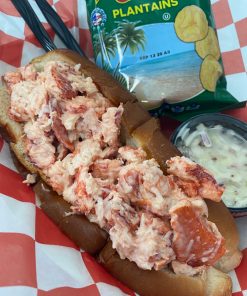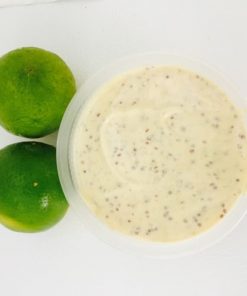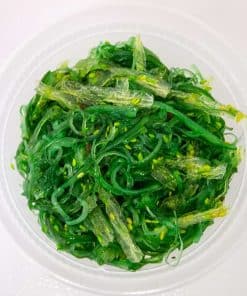
N.Y. Times Article
The actual article, published in 2008 is here. We’ve printed an extract below, just in case the New York Times website takes down the relevant page.
AT the Eaton Street Seafood Market in the historic district of Key West, Fla., a long glass case displayed a who’s who of the city’s seafood scene: plump piles of pinks (the local shrimp) snuggled next to a yellowtail snapper, a mound of stone crab claws and fresh slabs of grouper. I’d come to eat my way through Key West’s delicacies, and here was my map.
My first lesson, it turned out, would prove to be the most important. “I’m the only surviving specimen,” said Harvey Watkins, Eaton Street’s stone crab supplier, as we stood in the quiet little market, the crash and thrum of nearby Duval Street seemingly miles away. “I’m the last commercial fisherman in the old Key West harbor.”
It’s a story that Eaton Street Market’s owners, Damon Santelli and Sean Seaman, know well — and the reason they opened their shop last year. They want to sell fresh seafood caught by local fisherman, and buck the import trend they say is killing the local fishing industry. They also want to ensure that their customers get the real deal.
“Tourists come through and say, ‘Well, I can buy grouper in Chicago,’ ” Mr. Seaman said, shaking his head. “No, you can’t. It’s probably something else.”
For travelers looking to soak up some sunshine and sample the local bounty, a bag of stone crab claws from Eaton Street could well be Shangri-La. “People come in and want to go to Mallory Square or Fort Zach and have a picnic,” Mr. Seaman said as he cracked open a crab and handed me the “lollipop,” the lump claw meat.
Dipped in a housemade mustard sauce, the result was delicious — rich and meaty, like Alaskan king crab, but with more give. Starting at around $14 a pound, the claws are expensive, but buying them to go at Eaton Street costs less than half of what you’d pay in a sit-down restaurant.
What you do need to sit down for, however, is a proper fish sandwich. Just a short walk away, through the quiet streets of Old Town, B. O.’s Fish Wagon is a thumping little shanty-shack with a reputation for serving one of the best fish sandwiches in town. It deserves the hype — especially the fried “square grouper.” When it’s in stock, it’s topped with lettuce, tomato, onion and spiked with Key lime mayo ($10.75).
Buddy Owen, who owns B. O.’s, started selling his sandwich out of a wagon on Duval Street in the late 1970s. “We were there for close to 20 years,” he said, before a friend of his known as Panama Jack stepped in to pay for the restaurant. The late writer and humorist Shel Silverstein was a fan of B. O.’s, and Mr. Owen still cooks for the singer Jimmy Buffett when he comes to town.
Things weren’t always so easy for Mr. Owen; there was a time, he says, when the local authorities thought he was smuggling drugs. He wasn’t, but the name of his sandwich sure had them buzzing. Back in the 1970s, if you came home from fishing and said you had caught a square grouper, it meant that you had stumbled upon a bale of marijuana that had fallen off a boat from Jamaica. If you could manage to sell it off, it also meant that you didn’t have to go fishing for a while.
THE 1970s were heady days in Key West, and it was then that a young Norman Van Aken checked into town and discovered the basics for his New World Cuisine. He recently returned to Key West from Miami to open the swank Tavern N Town — a sexy, mahogany-lined restaurant with an open kitchen and white-cloth dining room in back.
“You become like a jazz artist, where you begin to riff,” said Mr. Van Aken, explaining his return. “But the roots of the Key West cuisine stabilize the riffing. If you’re somewhere without those deep roots, you can lose it.”
I’d come to sample his conch salad (conch is the sea snail that lives inside the spiral shell of the same name), which is named after Miss Betty, whom he met in 1978; she was a Bahamian woman who favored combat boots and straight talk in the kitchen. “Betty was just all real,” he said. “So when she showed me the conch salad, there were no embellishments. Just the conch, a little olive oil, a splash of orange, red onion, bell pepper, garlic.”
When Bahamians began migrating to Key West, in the early 1800s, they brought their staple food with them, earning them the nickname “conch.” But what was once a derogatory term for people who couldn’t afford better is now a source of pride used to describe anyone born in Key West, and conch has become the town’s most famous ingredient. So famous, in fact, that gathering it was banned in these waters by the federal government in 1985 because it had become an endangered species. Conch is now imported from the Caribbean; Mr. Van Aken only serves his salad when he can procure a good batch.
“That’s the trouble with any animal that moves slow and tastes good,” said Tom Hambright, a local historian. “We eat them all up.”
Spinning off of Miss Betty’s recipe, Mr. Van Aken dices his conch and vegetables into tender, tiny cubes, serving it in a martini glass. A cocktail shaker of marinade poured over it quickly pickles the raw conch into a ceviche ($11).
That process — sashimi-to-ceviche — is one I saw repeated by B. (short for Brother) Johnson the next day at Johnson’s Grocery, a corner market in Bahama Village with pictures of Bill Clinton, who visited last year, on the wall.
“Ceviche’s just a fancy word for conch salad,” said his wife, Brenda, pulling out her secret stash of chunks of conch, green pepper and tomato.
“Now that’s just street,” Mr. Johnson said, pointing to the raw conch. “That’s how I eat it. If you like, you can add a little lime juice or salt and pepper.”
















